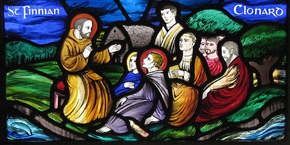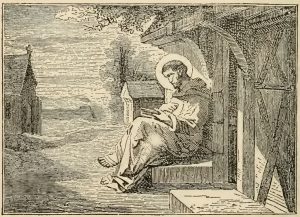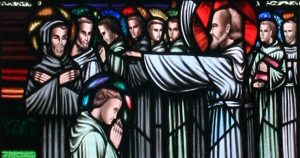
St. Finnian of Clonard was a renowned Irish teacher, founder, and abbot. Finnian was born in 470 at Myshal in County Carlow, Ireland.
MANY YEARS OF FORMATION
While still quite young, he was sent to be tutored by Bishop Fortchern of Trim. Thus began a long journey of prayer and study that would dominate the majority of his life. The second stop of his journey of study was at Tours in present day France, then known as Gaul or Gallia. The monastery there, founded in the fourth century by the venerable St. Martin of Tours, was one of the preeminent scholastic centers of Europe at the time. It had a strong reputation for not only its scholarship, but also its asceticism and solemnity. While there, Finnian, in addition to his studies, learned monastic life, and embraced that manner of life for the sake of the Gospel.

From Tours, he went to study in Wales (western modern day United Kingdom). There, he studied at Llancarfan in Glamorganshire under the mentoring of the saintly Cadoc, Gildas and David. He transcribed copies of many of the classical writings of antiquity as well as the Vulgate (Latin) Scriptures as translated by St. Jerome. Between his time at Tours and Wales, Finnian spent approximately thirty years in his scholastic and prayerful formation.
RETURN TO IRELAND
At an unknown date, Finnian returned to Ireland. He first went to County Wicklow and was granted a piece of land by King Oengus of Leinster in order to erect a church. From there, he went to County Kildare, where at Dunmanogue he established a church and a small monastic community at Skellig Michael. He then went to Kildare, where he studied further and taught at [St.] Brigid’s great monastery. At Kildare, he earned a great deal of respect from Brigid, who was elderly at the time and who bestowed a gold ring upon Finnian at the time of his departure. A legendary story tells that she knew he would need it, and indeed, Finnian came upon a man who needed the gold to gain his freedom.
In 520, Finnian, now about fifty years old, arrived at Clonard, located between the kingdoms of Leinster and Meath, in present day County Meath. Because the land was unoccupied, he could use as much land as he needed. He set out with the intention of establishing a monastic center for prayer and study, but he began by constructing a single small cell and a simple chapel made of wood and clay. There, he resumed his life of prayer, study, and ascetic practices. By that time, his reputation as a learned, wise, and holy man was established and he attracted many men, including some who were themselves accomplished scholars.
A GREAT MONASTERY BEGINS
With time, Finnian formed a great monastery from its humble beginnings. He was a gifted teacher, and since he was firmly grounded in a life of simplicity and poverty, he was incorruptible and greatly respected by his students. The rule for his monastery was very strict, but he didn’t ask more of his students than he was willing to do himself, including sleeping on a hard floor as a discipline and penance. Each of the penances were practiced in order to counter the sinful tendencies to which we all are subject. So highly regarded were Finnian’s lectures, that at its peak, the monastery had over three thousand men listening to his instruction about the Holy Scriptures. The students, some of whom were from beyond the British Isles, were usually gathered in an open field, reminiscent of the manner in which Our Lord taught.
TEACHER OF THE IRISH APOSTLES

Among Finnian’s students were the “Twelve Apostles of Erin”, including [St.] Brendan the Navigator, [St.] Columba of Iona, [St.] Ciaran of Clonmacnoise, and [St.] Colmcille. In The Book of Lismore, it is recorded that each of these “Apostles” was sent out with a copy of the Gospels, a crosier (staff), and a relic (of a saint) to use to build his own church. A terrible plague struck the area, beginning in 549, and while tending to the victims, Finnian fell ill himself. In order to prevent the disease from spreading throughout the monastery, he left Clonard and went to Ross Findchuill, a short distance away. There he died at approximately seventy-nine years of age, after having received Viaticum from his student Colmcille. His remains were housed at Clonard until the ninth century, when an attack of Danish Viking marauders sacked the monastery. The Abbey Church was destroyed in the tenth century, and only some ruins remain.
St. Finnian of Clonard spent nearly half of his life in his formation of prayer and study, which he put to splendid use as a teacher and leader in his homeland. Yet, he was not so isolated as to make himself unavailable during a time of great distress in his elder years. The foundation of his great school had a profound influence in Ireland for centuries after his death, especially regarding the Holy Scriptures. Finnian was a contemporary of [St] Benedict of Nursia, the abbot who is credited as the founder of monasticism in the Western Church, and Finnian accomplished something similarly great in his own land. In Belfast, a monastery named Clonard preserves the memory of the great Scriptural teacher. St. Finnian’s feast day is December 12.
